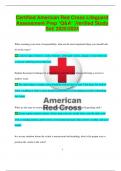Certified American Red Cross Lifeguard
Assessment Prep *Q&A* |Verified Study
Set| 2025/2024
When scanning your zone of responsibility, what are the most important things you should look
for in the water?
Look for signs of distress, weak swimmers, submerged victims, changes in water behavior,
or anyone exhibiting erratic behavior.
Explain the proper technique for a lifeguard to enter the water when performing a rescue in
shallow water.
The stride jump or compact jump should be used in water at least 5 feet deep. For shallow
water, a walking or slide-in entry should be performed to avoid injuring yourself or disturbing
the victim.
What are the steps to ensure proper surveillance during an open-water lifeguarding shift?
Ensure regular rotation of posts, always keep your eyes on the water, scan the entire zone
with a sweeping motion, and be aware of environmental factors like currents, weather, and wave
height.
In a rescue situation where the victim is unconscious but breathing, what is the proper way to
position the victim in the water?
1
, Place the victim in the recovery position, keeping their face out of the water and their airway
open, while providing in-water support until help arrives.
How does a lifeguard assess the risk of a spinal injury when a swimmer has hit their head?
Look for signs such as head, neck, or back pain, loss of movement, or numbness. Ask the
swimmer if they felt or heard a snap or crack and if they have difficulty moving.
What is the primary purpose of using a backboard in a spinal injury rescue?
A backboard immobilizes the victim's head, neck, and spine to prevent further injury during
extraction from the water.
When responding to a submerged victim in deep water, describe the proper sequence of actions.
Enter the water safely, swim to the victim, submerge using a feet-first surface dive, reach
under the victim’s arms, grasp their chin, pull them to the surface, and continue to tow them to
safety while providing rescue breathing if necessary.
What is the appropriate method to perform CPR for an adult victim as a lifeguard?
Perform 30 chest compressions followed by 2 rescue breaths. Ensure compressions are at
least 2 inches deep and at a rate of 100-120 compressions per minute.
What should a lifeguard do if they suspect a heart attack?
Call for emergency medical services, have the victim rest in a comfortable position, provide
aspirin if they are not allergic, monitor the victim, and prepare to administer CPR if needed.
2
, Why is it crucial to rotate lifeguard stations regularly during a shift?
Regular rotations prevent fatigue, maintain alertness, and ensure each lifeguard has a fresh
perspective on their zone of surveillance.
Explain how a lifeguard would handle a situation where multiple swimmers are in distress
simultaneously.
The lifeguard must signal for backup and prioritize rescues based on the severity of distress,
starting with the most serious, while keeping a constant eye on all victims until help arrives.
What are the key steps to managing a victim who has been pulled from the water but is
unconscious and not breathing?
Start with rescue breaths, perform CPR if no pulse is detected, and use an AED as soon as
possible. Continue care until emergency services arrive.
Describe the care procedure for a conscious victim who has suffered a seizure in the water.
Support the victim’s head above water, move them to shallow water if possible, and allow
the seizure to run its course. Once the seizure ends, remove the victim from the water and assess
their condition, providing first aid as necessary.
In what situations should a lifeguard activate the emergency action plan (EAP)?
The EAP should be activated in any serious emergency, such as drowning, unconsciousness,
cardiac arrest, or significant injury that requires professional medical assistance.
3




